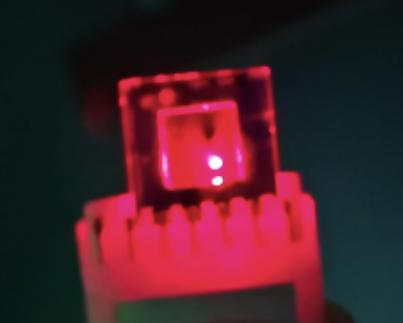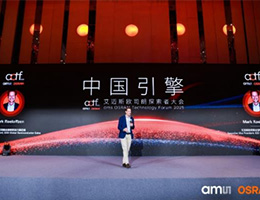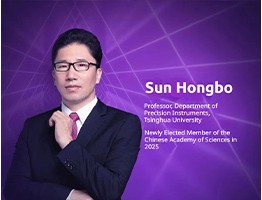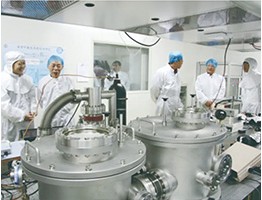From Cambridge to Haining, he made China's lasers light up the world for the first time
source:Zhejiang Daily
keywords:
Time:2025-11-04
Source: Zhejiang Daily 30th Oct 2025
In the laboratory of the International Joint College of Zhejiang University (Haining International Campus), a square device emits near-infrared laser light that is not directly perceptible to the naked eye — this is the world’s first electrically driven perovskite laser.
This breakthrough was achieved by a team led by Professor Di Dawei, Researcher Zou Chen, and Professor ZhAao Baodan from the College of Optical Science and Engineering, Zhejiang University, and Haining International Campus. The achievement was recently published in the top international academic journal Nature.
"An electrically driven perovskite laser can be seen as the 'Mount Everest' of the perovskite optoelectronics field," said Di Dawei. "It’s a goal pursued by thousands of research teams worldwide. After seven years of 'climbing,' our ZJU team was finally the first to plant China's flag at the summit."

Zou Chen, Di Dawei, Zhao Baodan
In 2014, the team of Di Dawei’s supervisor at the University of Cambridge developed the world’s first optically driven perovskite laser. However, the device was large and costly, making it hard to move toward practical applications. In 2018, Di returned to China and joined Zhejiang University, resolutely making the electrically driven perovskite laser his primary research direction. "Electrically driven perovskite lasers are smaller and more integrated; they can combine with silicon-based optoelectronic devices and are expected to find wide applications in wearable devices, optoelectronic chips, and biomedical fields in the future."
Yet the "climb" was no easy feat. Over seven years, he led his team to systematically plan and continuously tackle key challenges toward this goal. "Developing an electrically driven perovskite laser is like building a complete car—every component, from the engine and chassis to the transmission, must be solid," Di analogized.

Experimental photo of an electrically driven perovskite laser
In May last year, the team finally saw a turning point — they observed the long-awaited electrically pumped lasing phenomenon for the first time. To ensure the reliability of the results, they conducted repeated tests, ruled out all possible factors that could lead to misjudgment, and only stopped when the experiment could be stably replicated time and again. After months of optimization and verification, the team finally ///confirm/i/i/ied: the world’s first electrically driven perovskite laser had been born at Zhejiang University. This achievement was officially published in Nature on August 27 this year. But David Di emphasized, “This is just a new starting point. The electrically driven perovskite laser is still in its ‘infancy’; our next focus is to improve its stability and push it toward practical applications.”
Choosing to settle at Haining International Campus was “a mutual choice” for Di’s team. “Haining Campus not only provides ample laboratory space but also offers crucial support through supporting projects and policies,” Di said. “The government has the patience to support high-risk frontier research, which is exactly the soil that scientific research needs most.” He was also impressed by the campus’s international atmosphere. It collaborates with world-renowned universities such as the University of Illinois Urbana-Champaign and the University of Edinburgh in running programs, taking root in China while connecting with the world.

From a student to a team leader, Di Dawei once worried that he would no longer be able to do experiments with his own hands or be the "primary discoverer" as he used to be. But now he has found new value: "Planning and designing research projects, exchanging ideas with team members, and analyzing data — this process not only inspires them, but also inspires me in turn. Although I can no longer be a 'forward' scoring goals directly, being a 'coach' who develops tactics and leads the team toward higher goals is equally fulfilling."
As a PhD supervisor, Di has a unique approach to mentoring. "When I recruit students, what I value most is whether they have a genuine passion for research, not their academic test scores," he said. He added that he never requires students to clock in, but instead encourages them to explore freely. "I often tell my students: The mission of a PhD student is to create new knowledge and invent new technologies. Your research could well be the best in the world — leave your mark in this field."
During his years at Zhejiang University, Di’s team has achieved a steady stream of results: the world’s first electrically driven perovskite laser, the world’s smallest micro perovskite LED, ultra-high-brightness electroluminescence, long-lifetime perovskite LEDs... Each represents a leap from zero to one (i.e., a breakthrough from scratch). In his view, the true breakthrough in scientific research lies not only in the achievements themselves, but more importantly in nurturing a new generation of bold explorers. "I hope more young people will step into academic 'uncharted territories' with curiosity and passion, and climb one 'Mount Everest' after another," Di said. "May the story of China’s zero-to-one scientific research continue."
 9th Secret Light Awards Launch: Million-Yuan Fund + National Award Recommendation
9th Secret Light Awards Launch: Million-Yuan Fund + National Award Recommendation Top Enterprises Gather: 1st Laser & Additive Manufacturing Innovation Conference Wraps Up
Top Enterprises Gather: 1st Laser & Additive Manufacturing Innovation Conference Wraps Up 2025 ams OSRAM Explorer Conference: "China Engine" Drives Future Innovation
2025 ams OSRAM Explorer Conference: "China Engine" Drives Future Innovation Tsinghua's Sun Hongbo, SLA Review Expert, Becomes CAS Academician
Tsinghua's Sun Hongbo, SLA Review Expert, Becomes CAS Academician 4th Collaboration! What Brought the Global Laser Academic Guru to Chinese Univs & Leading Firms?
4th Collaboration! What Brought the Global Laser Academic Guru to Chinese Univs & Leading Firms?
 Scanner Optics: Galvanometer Tech Leader
Scanner Optics: Galvanometer Tech Leader The "Light Chasers" in the Deep Ultraviolet World
The "Light Chasers" in the Deep Ultraviolet World Shi Lei (Hipa Tech): Focus on Domestic Substitution, Future Layout in High-End Laser Micromachining
Shi Lei (Hipa Tech): Focus on Domestic Substitution, Future Layout in High-End Laser Micromachining Optizone Technology: 17 Years Devoted to Optics – High-Power Optics Mass-Production Pioneer
Optizone Technology: 17 Years Devoted to Optics – High-Power Optics Mass-Production Pioneer Zhuojie Laser: Breaking barriers via tech breakthroughs, aiming to lead high-end light sources
more>>
Zhuojie Laser: Breaking barriers via tech breakthroughs, aiming to lead high-end light sources
more>>
